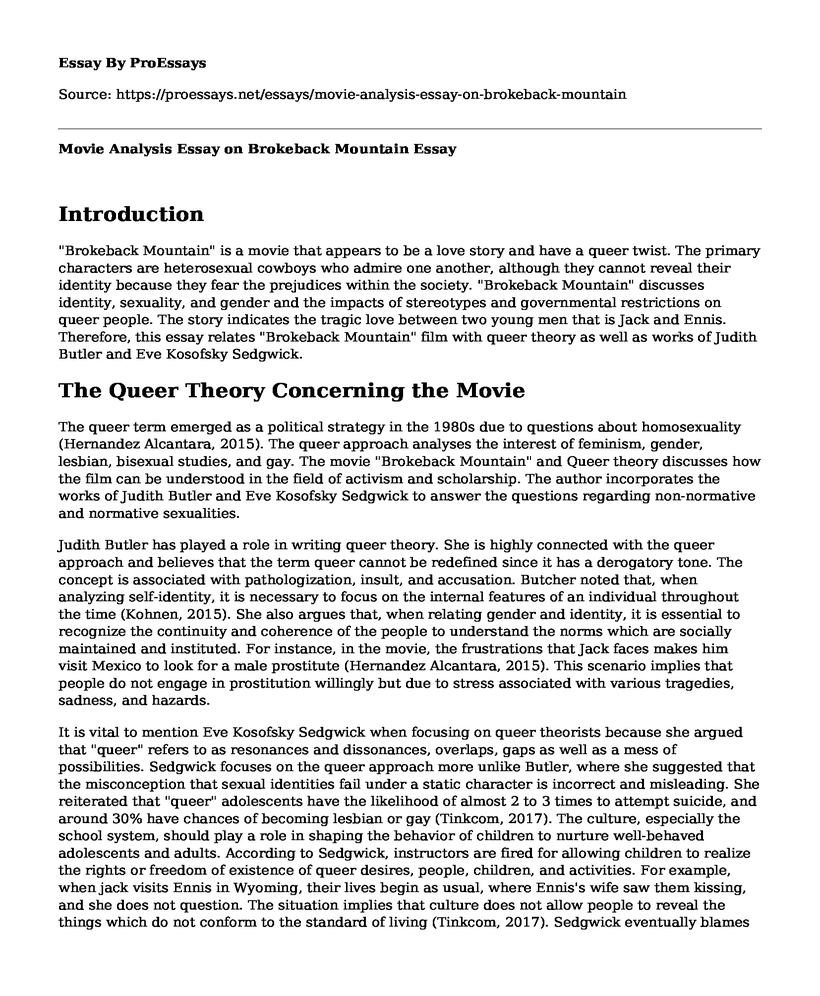Introduction
"Brokeback Mountain" is a movie that appears to be a love story and have a queer twist. The primary characters are heterosexual cowboys who admire one another, although they cannot reveal their identity because they fear the prejudices within the society. "Brokeback Mountain" discusses identity, sexuality, and gender and the impacts of stereotypes and governmental restrictions on queer people. The story indicates the tragic love between two young men that is Jack and Ennis. Therefore, this essay relates "Brokeback Mountain" film with queer theory as well as works of Judith Butler and Eve Kosofsky Sedgwick.
The Queer Theory Concerning the Movie
The queer term emerged as a political strategy in the 1980s due to questions about homosexuality (Hernandez Alcantara, 2015). The queer approach analyses the interest of feminism, gender, lesbian, bisexual studies, and gay. The movie "Brokeback Mountain" and Queer theory discusses how the film can be understood in the field of activism and scholarship. The author incorporates the works of Judith Butler and Eve Kosofsky Sedgwick to answer the questions regarding non-normative and normative sexualities.
Judith Butler has played a role in writing queer theory. She is highly connected with the queer approach and believes that the term queer cannot be redefined since it has a derogatory tone. The concept is associated with pathologization, insult, and accusation. Butcher noted that, when analyzing self-identity, it is necessary to focus on the internal features of an individual throughout the time (Kohnen, 2015). She also argues that, when relating gender and identity, it is essential to recognize the continuity and coherence of the people to understand the norms which are socially maintained and instituted. For instance, in the movie, the frustrations that Jack faces makes him visit Mexico to look for a male prostitute (Hernandez Alcantara, 2015). This scenario implies that people do not engage in prostitution willingly but due to stress associated with various tragedies, sadness, and hazards.
It is vital to mention Eve Kosofsky Sedgwick when focusing on queer theorists because she argued that "queer" refers to as resonances and dissonances, overlaps, gaps as well as a mess of possibilities. Sedgwick focuses on the queer approach more unlike Butler, where she suggested that the misconception that sexual identities fail under a static character is incorrect and misleading. She reiterated that "queer" adolescents have the likelihood of almost 2 to 3 times to attempt suicide, and around 30% have chances of becoming lesbian or gay (Tinkcom, 2017). The culture, especially the school system, should play a role in shaping the behavior of children to nurture well-behaved adolescents and adults. According to Sedgwick, instructors are fired for allowing children to realize the rights or freedom of existence of queer desires, people, children, and activities. For example, when jack visits Ennis in Wyoming, their lives begin as usual, where Ennis's wife saw them kissing, and she does not question. The situation implies that culture does not allow people to reveal the things which do not conform to the standard of living (Tinkcom, 2017). Sedgwick eventually blames the government of the United States for initiating some acts which affect the research on teen's sexual behavior, where she concludes that society wants "queer" kids to die or conform.
Therefore, "Brokeback Mountain" is a romantic film that depicts the complicated sexual and emotional relationship between Jack Twist and Dennis Del Mar. The movie received commercial success and critical acclaim since it won the Golden Lion in Venice. Thus, the film has incorporated queer theory and the work of Judith Butler and Eve Kosofsky Sedgwick to answer the questions regarding non-normative and normative sexualities.
References
Kohnen, M. (2015). Queer representation, visibility, and race in American film and television: Screening the closet. Routledge.
Tinkcom, M. (2017). Queer Theory and Brokeback Mountain. Bloomsbury Publishing USA.
Hernandez Alcantara, M. T. (2015). New Queer Cinema in the USA: Rejecting Heteronormative Categorisations in Desert Hearts (1985) and Brokeback Mountain (2005).
Cite this page
Movie Analysis Essay on Brokeback Mountain. (2023, Feb 26). Retrieved from https://proessays.net/essays/movie-analysis-essay-on-brokeback-mountain
If you are the original author of this essay and no longer wish to have it published on the ProEssays website, please click below to request its removal:
- Is Facebook Making Us Lonely?
- Gender Inequality and Discrimination of Lesbians Paper Example
- Essay Example on Renaissance Era: Music & Universe Changes (1450-1600)
- Essay Sample on Middle School: An Inspiring Fight for What's Right
- Essay on It's a Social-Media-Filled World: Nobody Takes You Seriously Without It
- Essay on Popularity of Instagram Among 126 Study Participants: High Purchase of Goods Observed
- Essay Example on Global Fashion Industry







